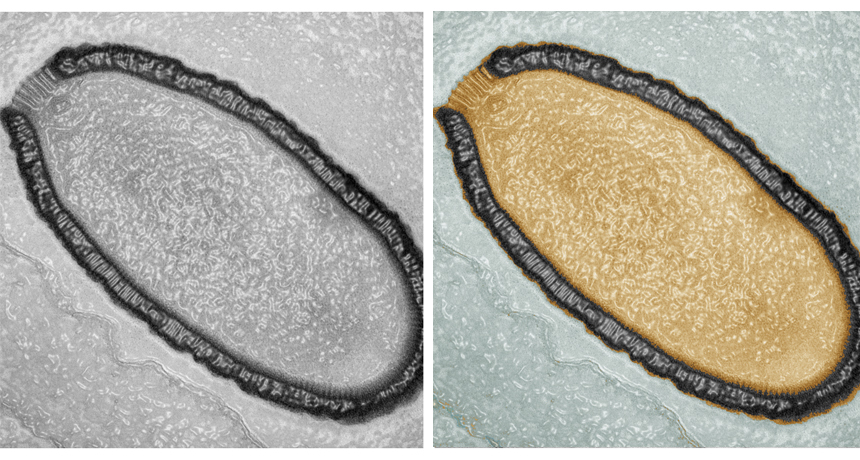Return of the giant zombie virus
After being frozen for 30,000 years, the world's biggest known virus can still infect

The new mega-virus, Pithovirus sibericum (surrounded by a dark outer coating and viewed with two different methods) rests within the single-celled amoeba that it infected.
JULIABARTOLI AND CHANTAL ABERGEL, IGS AND CNRS-AMU
For more than 30,000 years, a giant virus lay frozen in northern Russia. It’s the largest virus ever discovered. And it’s not frozen any more. Even after so many millennia in cold storage, the virus is still infectious. Scientists have named this so-called “zombie” virus Pithovirus sibericum.
“It’s quite different from the giant viruses already known,” Eugene Koonin told Science News. A biologist at the National Center for Biotechnology Information in Bethesda, Md., he did not work on the new microbe.
The word “virus” usually makes people think about illness. And viruses can cause a wide range of diseases, from the common cold to polio and AIDS. But there’s no need for people to panic about the new germ. The mega-virus appears toinfect only other single-celled organisms known as amoebas.
This new virus can survive long periods in permafrost. These layers of soil stay frozen year-round. But climate change has begun to thaw permafrost in many regions. That could release other long-frozen viruses. And some of those may indeed pose a threat to people, warn the scientists who just unearthed the new giant virus.
Biologists Jean-Michel Claverie and Chantal Abergel, at Aix-Marseille University in France, found the new germ. At 1.5 micrometers (about six hundred-thousandths of an inch), it’s about as long as 15 particles of HIV — the virus that causes AIDS — laid end to end. They describe it in a study published March 3 in the Proceedings of the National Academy of Sciences.
Claverie and Abergel are no strangers to huge viruses. They helped discover the first giant, about 10 years ago. That one was large enough to be seen under an ordinary microscope. Its name, Mimivirus, is short for “mimicking microbes.” Indeed, it was so large that scientists first thought it was a living organism. In fact, viruses are not technically alive because they can’t reproduce on their own.
Until the discovery of Mimivirus, “we had this silly idea that all viruses were basically very small,” Claverie told Science News.
Then, last summer, his group identified a second family of giant viruses. Nowthey’ve pinpointed yet another whole new family. Giant viruses, as it turns out, come in many varieties. And that’s basically been adding to the confusion of what to expect from viruses, says Claverie. Indeed, “with this Pithovirus, we are totally lost.”
The scientists stumbled onto the new Siberia sleeper virus quite by accident. They had heard about an ancient plant that had been revived from permafrost. So they obtained permafrost and added the soil to dishes containing amoebas. When all of the amoebas died, they went looking for the cause. That’s when they found the new giant virus.
Now, with the new finding, scientists don’t know just how large viral particles can get, says Koonin of the National Center for Biotechnology Information. “I would be excited but not terribly surprised if something even larger comes up tomorrow,” he says.
Power Words
AIDS (short for Acquired Immune Deficiency Syndrome) A disease that weakens a body’s immune system, greatly lowering resistance to infections and some cancers. It is caused by the HIV germ. (See also HIV)
amoeba A single-celled microbe that catches food and moves about by extending fingerlike projections of a colorless material called protoplasm. Amoebas are either free-living in damp environments or they are parasites.
biology The study of living things. The scientists who study them are known as biologists.
HIV (short for Human Immunodeficiency Virus) A potentially deadly virus that attacks cells in the body’s immune system and causes acquired immune deficiency syndrome, or AIDS.
infection A disease that can be transmitted between organisms.
infectious A germ that can be transmitted to people, animals or other living things
parasite A creature that gets a benefit from another organism, called a host, but doesn’t provide it any benefits. Classic examples of parasites include ticks, fleas and tapeworms.
particle A minute amount of something.
permafrost Permanently frozen ground.
polio An infectious viral disease that affects the central nervous system and can cause temporary or permanent paralysis.
virus Tiny infectious agents consisting of RNA or DNA surrounded by protein. Viruses can reproduce only by injecting their genetic material into the cells of living creatures. Although scientists frequently refer to viruses as live or dead, in fact no virus is truly alive. It doesn’t eat like animals do, or make its own food the way plants do. It must hijack the cellular machinery of a living cell in order to survive.







